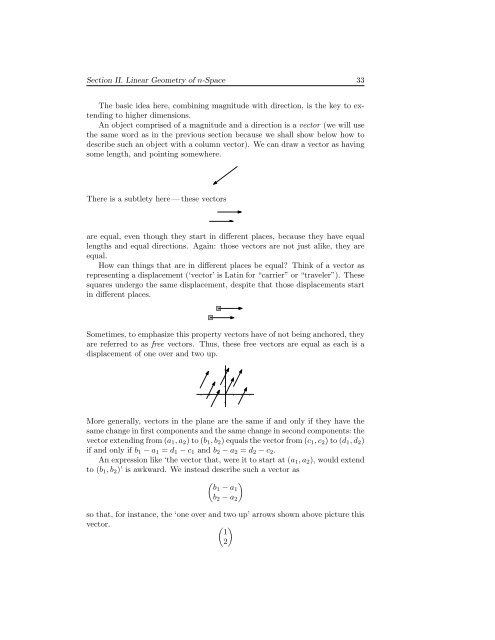Linear Algebra - Free Books
Linear Algebra - Free Books
Linear Algebra - Free Books
Create successful ePaper yourself
Turn your PDF publications into a flip-book with our unique Google optimized e-Paper software.
Section II. <strong>Linear</strong> Geometry of n-Space 33The basic idea here, combining magnitude with direction, is the key to extendingto higher dimensions.An object comprised of a magnitude and a direction is a vector (we will usethe same word as in the previous section because we shall show below how todescribe such an object with a column vector). We can draw a vector as havingsome length, and pointing somewhere.There is a subtlety here — these vectorsare equal, even though they start in different places, because they have equallengths and equal directions. Again: those vectors are not just alike, they areequal.How can things that are in different places be equal? Think of a vector asrepresenting a displacement (‘vector’ is Latin for “carrier” or “traveler”). Thesesquares undergo the same displacement, despite that those displacements startin different places.Sometimes, to emphasize this property vectors have of not being anchored, theyare referred to as free vectors. Thus, these free vectors are equal as each is adisplacement of one over and two up.More generally, vectors in the plane are the same if and only if they have thesame change in first components and the same change in second components: thevector extending from (a 1 , a 2 ) to (b 1 , b 2 ) equals the vector from (c 1 , c 2 ) to (d 1 , d 2 )if and only if b 1 − a 1 = d 1 − c 1 and b 2 − a 2 = d 2 − c 2 .An expression like ‘the vector that, were it to start at (a 1 , a 2 ), would extendto (b 1 , b 2 )’ is awkward. We instead describe such a vector as(b1 − a 1b 2 − a 2)so that, for instance, the ‘one over and two up’ arrows shown above picture thisvector. ( 12)
















